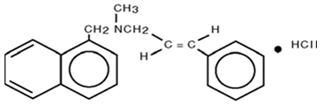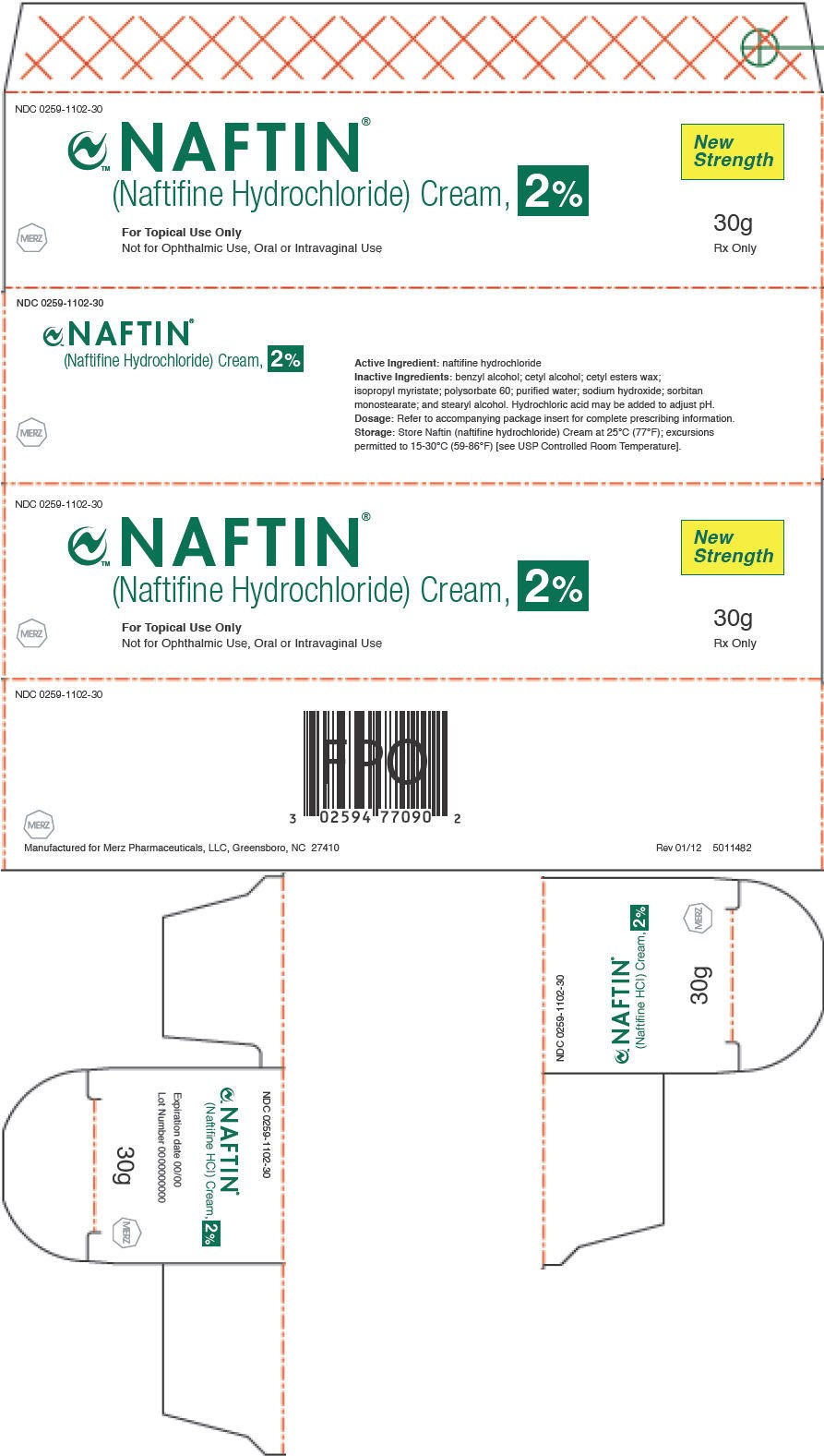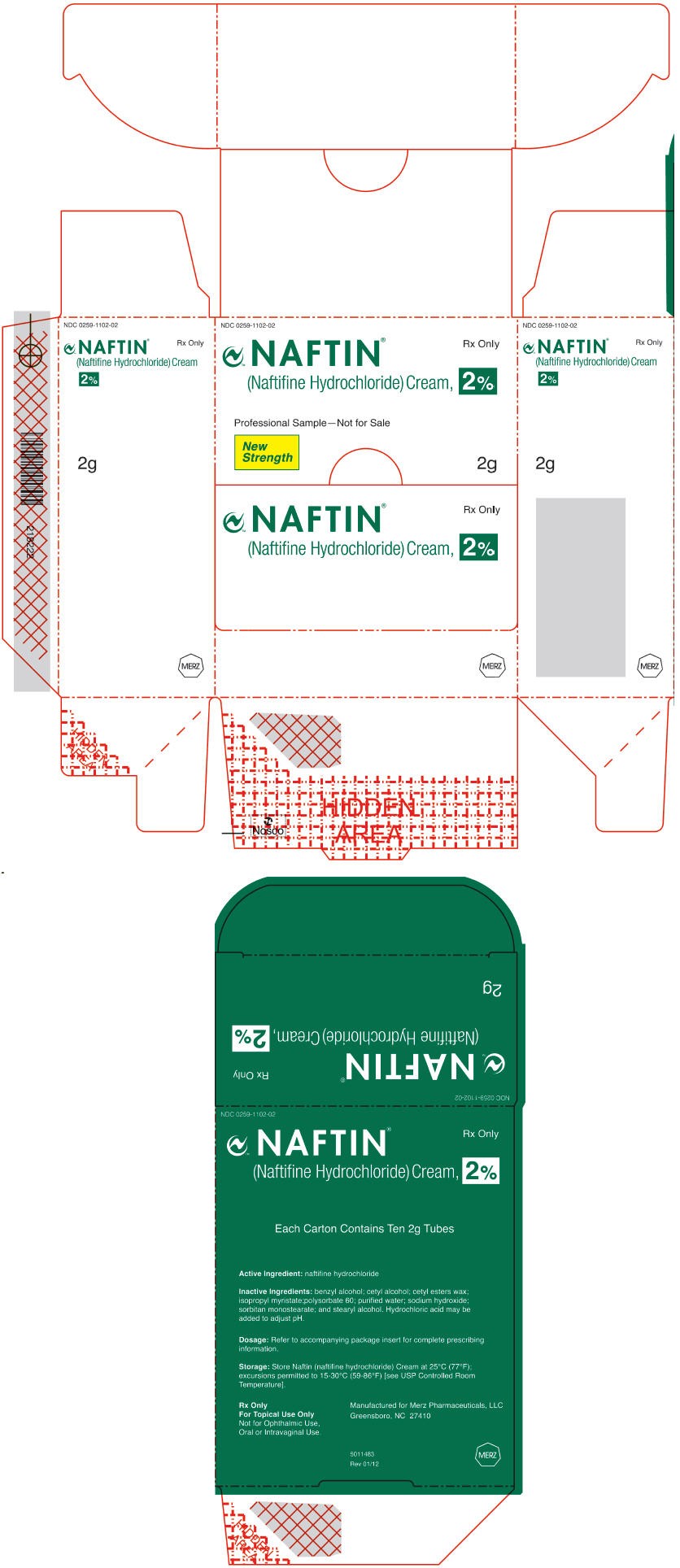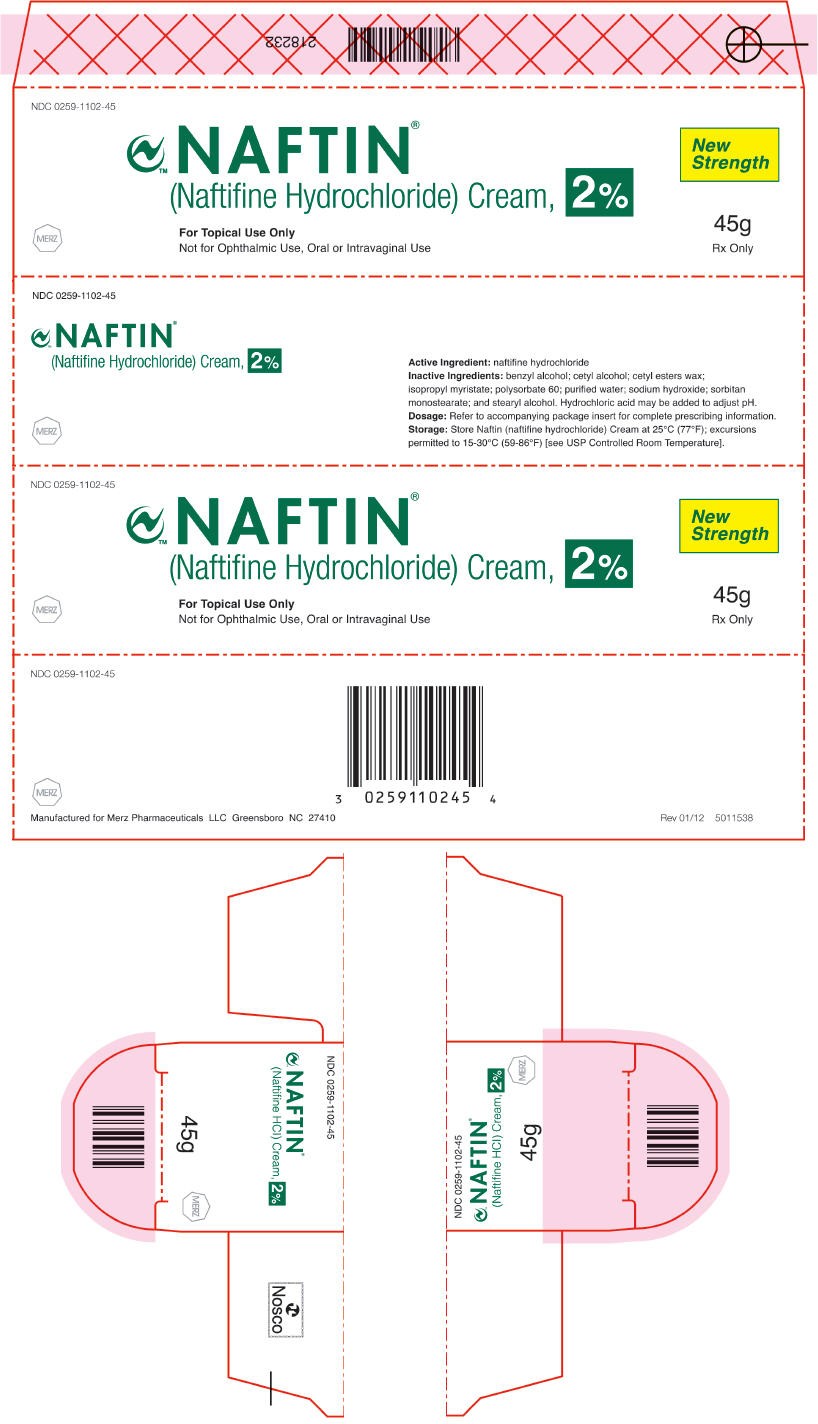Naftin
HIGHLIGHTS OF PRESCRIBING INFORMATIONThese highlights do not include all the information needed to use NAFTIN Cream, 2% safely and effectively. See full prescribing information for NAFTIN (naftifine hydrochloride) Cream, 2%. NAFTIN (naftifine hydrochloride) Cream, 2% for topical useInitial U.S. Approval: 1988INDICATIONS AND USAGENAFTIN (naftifine hydrochloride) Cream, 2% is an allylamine antifungal indicated for the treatment of interdigital tinea pedis, tinea cruris, and tinea corporis caused by the organism Trichophyton rubrum in adult patients ≥18 years of age. (1)DOSAGE AND ADMINISTRATIONFor topical use only. NAFTIN (naftifine hydrochloride) Cream, 2% is not for ophthalmic, oral, or intravaginal use. (2)Apply a thin layer of NAFTIN (naftifine hydrochloride) Cream, 2% once-daily to the affected areas plus a ½ inch margin of healthy surrounding skin for 2 weeks. (2)DOSAGE FORMS AND STRENGTHSCream: 2% (3)CONTRAINDICATIONSNone (4)WARNINGS AND PRECAUTIONSIf redness or irritation develops with the use of NAFTIN Cream, 2% treatment should be discontinued. (5.1)Side EffectsThe most common adverse reaction (≥1%) is pruritus. (6.1) To report SUSPECTED ADVERSE REACTIONS, contact Merz Pharmaceuticals, LLC at 877-743-8454 or FDA at 1-800-FDA-1088 or www.fda.gov/medwatch.
FULL PRESCRIBING INFORMATION: CONTENTS*
- 1 NAFTIN INDICATIONS AND USAGE
- 2 NAFTIN DOSAGE AND ADMINISTRATION
- 3 DOSAGE FORMS AND STRENGTHS
- 4 NAFTIN CONTRAINDICATIONS
- 5 WARNINGS AND PRECAUTIONS
- 6 NAFTIN ADVERSE REACTIONS
- 8 USE IN SPECIFIC POPULATIONS
- 11 NAFTIN DESCRIPTION
- 12 CLINICAL PHARMACOLOGY
- 13 NONCLINICAL TOXICOLOGY
- 14 CLINICAL STUDIES
- 16 HOW SUPPLIED/STORAGE AND HANDLING
- 17 PATIENT COUNSELING INFORMATION
FULL PRESCRIBING INFORMATION
1 INDICATIONS AND USAGE
NAFTIN (naftifine hydrochloride) Cream, 2% is indicated for the treatment of: interdigital tinea pedis, tinea cruris, and tinea corporis caused by the organism Trichophyton rubrum in adult patients ≥18 years of age.
2 DOSAGE AND ADMINISTRATION
For topical use only. NAFTIN (naftifine hydrochloride) Cream, 2% is not for ophthalmic, oral or intravaginal use. Apply a thin layer of NAFTIN Cream, 2% once-daily to the affected areas plus a ½ inch margin of healthy surrounding skin for 2 weeks.
3 DOSAGE FORMS AND STRENGTHS
Cream: 2%, white to off-white cream
4 CONTRAINDICATIONS
None
5 WARNINGS AND PRECAUTIONS
5.1 Local Side Effects
If irritation or sensitivity develops with the use of NAFTIN (naftifine hydrochloride) Cream, 2% treatment should be discontinued. Patients should be directed to contact their physician if these conditions develop following use of NAFTIN (naftifine hydrochloride) Cream, 2%.
6 ADVERSE REACTIONS
6.1 Clinical Trials Experience
Because clinical trials are conducted under widely varying conditions, adverse reaction rates observed in the clinical trials of a drug cannot be directly compared to rates in the clinical trials of another drug and may not reflect the rates observed in practice.
During clinical trials, 760 subjects were exposed to naftifine 1% and 2% cream formulations. A total of 421 subjects with tinea pedis and/or tinea cruris were treated with NAFTIN (naftifine hydrochloride) Cream, 2%. In two randomized, vehicle-controlled trials (400 patients were treated with NAFTIN (naftifine hydrochloride) Cream, 2%). The population was 12 to 88 years old, primarily male (79%), 48% Caucasian, 36% Black or African American, 40% Hispanic or Latino and had either predominantly interdigital tinea pedis or tinea cruris. Most subjects received doses once-daily, topically, for 2 weeks to cover the affected skin areas plus a ½ inch margin of surrounding healthy skin. In the two vehicle-controlled trials, 17.5% of NAFTIN (naftifine hydrochloride) Cream, 2% treated subjects experienced an adverse reaction compared with 19.3% of vehicle subjects. The most common adverse reaction (≥1%) is pruritus. Most adverse reactions were mild in severity. The incidence of Adverse Reactions in the NAFTIN Cream, 2% treated population were not significantly different than the vehicle treated population.
6.2 Postmarketing Experience
The following adverse reactions have been identified during postmarketing use of (naftifine hydrochloride): redness/irritation, inflammation, maceration, swelling, burning, blisters, serous drainage, crusting, headache, dizziness, leukopenia, agranulocytosis. Because these reactions are reported voluntarily from a population of uncertain size, it is not always possible to reliably estimate their frequency or establish a causal relationship to drug exposure.
8 USE IN SPECIFIC POPULATIONS
8.1 Pregnancy
Pregnancy Category B. There are no adequate and well-controlled studies of NAFTIN (naftifine hydrochloride) Cream, 2% in pregnant women. Because animal reproduction studies are not always predictive of human response, NAFTIN (naftifine hydrochloride) Cream, 2% should be used during pregnancy only if the potential benefit justifies the potential risk to the fetus.
The animal multiples of human exposure calculations were based on daily dose body surface area comparison (mg/m2) for the reproductive toxicology studies described in this section and in Section 13.1. The Maximum Recommended Human Dose (MRHD) was set at 8 g 2% cream per day (2.67 mg/kg/day for a 60 kg individual).
Systemic embryofetal development studies were conducted in rats and rabbits. Oral doses of 30, 100 and 300 mg/kg/day naftifine hydrochloride were administered during the period of organogenesis (gestational days 6 – 15) to pregnant female rats. No treatment-related effects on embryofetal toxicity or teratogenicity were noted at doses up to 300 mg/kg/day (18.2× MRHD). Subcutaneous doses of 10 and 30 mg/kg/day naftifine hydrochloride were administered during the period of organogenesis (gestational days 6 – 15) to pregnant female rats. No treatment-related effects on embryofetal toxicity or teratogenicity were noted at 30 mg/kg/day (1.8× MRHD). Subcutaneous doses of 3, 10 and 30 mg/kg/day naftifine hydrochloride were administered during the period of organogenesis (gestational days 6 – 18) to pregnant female rabbits. No treatment related effects on embryofetal toxicity or teratogenicity were noted at 30 mg/kg/day (3.6× MRHD).
A peri- and post-natal development study was conducted in rats. Oral doses of 30, 100 and 300 mg/kg/day naftifine hydrochloride were administered to female rats from gestational day 14 to lactation day 21. Reduced body weight gain of females during gestation and of the offspring during lactation was noted at 300 mg/kg/day (18.2× MRHD). No developmental toxicity was noted at 100 mg/kg/day (6.1× MRHD).
8.3 Nursing Mothers
It is not known whether this drug is excreted in human milk. Because many drugs are excreted in human milk, caution should be exercised when NAFTIN (naftifine hydrochloride) Cream, 2% is administered to a nursing woman.
8.4 Pediatric Use
Safety and effectiveness in pediatric patients have not been established. The number of pediatric patients ≥12 years of age studied were too small to adequately assess safety and efficacy.
8.5 Geriatric Use
Clinical studies of NAFTIN (naftifine hydrochloride) Cream, 2% did not include sufficient numbers of subjects aged 65 and over to determine whether they respond differently from younger subjects.
11 DESCRIPTION
NAFTIN (naftifine hydrochloride) Cream, 2% is a white to off-white cream for topical use only. Each gram of (naftifine hydrochloride) Cream contains 20 mg of naftifine hydrochloride, a synthetic allylamine antifungal compound.
Chemically, naftifine HCl is (E)-N-Cinnamyl-N-methyl-1-napthalenemethylamine hydrochloride.
The molecular formula is C21H21N•HCl with a molecular weight of 323.86.
The structural formula of naftifine hydrochloride is:

NAFTIN (naftifine hydrochloride) Cream, 2% contains the following inactive ingredients: benzyl alcohol, cetyl alcohol, cetyl esters wax, isopropyl myristate, polysorbate 60, purified water, sodium hydroxide, sorbitan monostearate, stearyl alcohol, and hydrochloric acid.
12 CLINICAL PHARMACOLOGY
12.1 Mechanism of Action
NAFTIN (naftifine hydrochloride) Cream, 2% is a topical antifungal drug [see Clinical Pharmacology(12.4)]
12.2 Pharmacodynamics
The pharmacodynamics of NAFTIN (naftifine hydrochloride) Cream, 2% have not been established.
12.3 Pharmacokinetics
In vitro and in vivo bioavailability studies have demonstrated that naftifine penetrates the stratum corneum in sufficient concentration to inhibit the growth of dermatophytes.
The pharmacokinetics of NAFTIN Cream, 2% was evaluated following once-daily topical application for 2 weeks to twenty one adult subjects, both males and females, with both tinea pedis and tinea cruris. The median total amount of cream applied was 6.4 g (range 5.3-7.5 g) per day. The results showed that the systemic exposure (i.e. maximum concentration (Cmax) and area under the curve (AUC)) to naftifine increased over the 2 week treatment period in all the 21 subjects. Geometric Mean (CV%) AUC0-24 was 117 (41.2) ng*hr/mL on Day 1, and 204 (28.5) ng*hr/mL on Day 14. Geometric Mean (CV %) Cmax was 7 ng/mL (55.6) on Day 1 and 11 ng/mL (29.3) on day 14. Median Tmax was 8.0 hours on Day 1 (range: 4 to 24) and 6.0 hours on Day 14 (range: 0 to 16). Accumulation after 14 days of topical application was less than two fold. Trough concentrations generally increased throughout the 14 day study period. Naftifine continued to be detected in plasma in 13/21 (62%) subjects on day 28, the mean (SD) plasma concentrations were 1.6 ± 0.5 ng/mL (range below limit of quantitation (BLQ) to 3 ng/mL).
In the same pharmacokinetic study conducted in patients with tinea pedis and tinea cruris, median fraction of the dose excreted in urine during the treatment period was 0.0016% on Day 1 versus 0.0020% on Day 14.
12.4 Microbiology
Although the exact mechanism of action against fungi is not known, naftifine hydrochloride appears to interfere with sterol biosynthesis by inhibiting the enzyme squalene 2, 3-epoxidase.This inhibition of enzyme activity results in decreased amounts of sterols, especially ergosterol, and a corresponding accumulation of squalene in the cells.
Naftifine has been shown to be active against most isolates of the following fungi, both in vitro and in clinical infections, as described in the INDICATIONS AND USAGE section:
-
13 NONCLINICAL TOXICOLOGY
13.1 Carcinogenesis, Mutagenesis, Impairment of Fertility
Long-term studies to evaluate the carcinogenic potential of NAFTIN (naftifine hydrochloride) Cream, 2% have not been performed.
Naftifine hydrochloride revealed no evidence of mutagenic or clastogenic potential based on the results of two in vitro genotoxicity tests (Ames assay and Chinese hamster ovary cell chromosome aberration assay) and one in vivo genotoxicity test (mouse bone marrow micronucleus assay).
Oral administration of naftifine hydrochloride to rats, throughout mating, gestation, parturition and lactation, demonstrated no effects on growth, fertility or reproduction, at doses up to 100 mg/kg/day (6.1× MRHD).
14 CLINICAL STUDIES
14.1 Tinea Cruris
NAFTIN (naftifine hydrochloride) Cream, 2% has been investigated for safety and efficacy in a randomized, double-blind, vehicle-controlled, multi-center study in 146 subjects with symptomatic and dermatophyte culture positive tinea cruris. Subjects were randomized to receive (naftifine hydrochloride) Cream or vehicle. Subjects applied the study agent (naftifine hydrochloride) Cream or vehicle) to the affected area plus a ½-inch margin of healthy skin surrounding the affected area once-daily for 2 weeks. Signs and symptoms of tinea cruris (presence or absence of erythema, pruritus, and scaling) were assessed, and KOH examination and dermatophyte culture were performed at the primary efficacy endpoint at week 4.
The mean age of the study population was 47 years and 87% were male and 43% were white. At baseline, subjects were confirmed to have signs and symptoms of tinea cruris, positive KOH exam, and confirmed dermatophyte presence based on culture results from a central mycology laboratory. The analysis of the intent-to-treat population was a comparison of the proportions of subjects with a complete cure at the week 4 visit (see Table 1). Complete cure was defined as both clinical cure (absence of erythema, pruritus, and scaling) and mycological cure (negative KOH and dermatophyte culture).
The percentage of subjects experiencing clinical cure and the percentage of subjects experiencing mycological cure at week 4 are presented individually in Table 1 below
| Endpoint | NAFTIN (naftifine hydrochloride) Cream, 2% N=75 |
VehicleN=71 |
|---|---|---|
| Complete Cure |
19(25%) | 2(3%) |
| Effective Treatment |
45(60%) | 7(10%) |
| Mycological Cure |
54(72%) | 11(16%) |
14.2 Interdigital Tinea Pedis
NAFTIN (naftifine hydrochloride)Cream, 2% has been investigated for efficacy in a randomized, double-blind, vehicle-controlled, multi-center study in 217 subjects with symptomatic and dermatophyte culture positive tinea pedis. Subjects were randomized to receive NAFTIN (naftifine hydrochloride) Cream, 2% or vehicle. Subjects applied the study agent (naftifine hydrochloride) Cream or vehicle) to the affected area of the foot plus a ½-inch margin of healthy skin surrounding the affected area once-daily for 2 weeks. Signs and symptoms of tinea pedis (presence or absence of erythema, pruritus, and scaling) were assessed and KOH examination and dermatophyte culture was performed at the primary efficacy endpoint at week 6.
The mean age of the study population was 42 years and 71% were male and 57% were white. At baseline, subjects were confirmed to have signs and symptoms of tinea pedis, positive KOH exam, and confirmed dermatophyte culture. The primary efficacy endpoint was the proportions of subjects with a complete cure at the week 6 visit (see Table 2). Complete cure was defined as both a clinical cure (absence of erythema, pruritus, and scaling) and mycological cure (negative KOH and dermatophyte culture).
The efficacy results at week 6, four weeks following the end of treatment, are presented in Table 2 below. Naftin Cream demonstrated complete cure in subjects with interdigital tinea pedis, but complete cure in subjects with only moccasin type tinea pedis was not demonstrated.
| Endpoint | NAFTIN (naftifine hydrochloride) Cream, 2% N=147 |
Vehicle N=70 |
|---|---|---|
| Complete Cure |
26(18%) | 5(7%) |
| Effective Treatment |
83(57%) | 14(20%) |
| Mycological Cure |
99(67%) | 15(21%) |
16 HOW SUPPLIED/STORAGE AND HANDLING
How Supplied
NAFTIN (naftifine hydrochloride) Cream, 2% is a white to off-white cream supplied in collapsible tubes in the following sizes:
30g – NDC 0259-1102-30
45g – NDC 0259-1102-45
60g – NDC 0259-1102-60
Storage
Store NAFTIN (naftifine hydrochloride) Cream, 2% at 25°C (77°F); excursions permitted to 15-30°C (59-86°F) [see USP Controlled Room Temperature].
17 PATIENT COUNSELING INFORMATION
- Inform patients that NAFTIN (naftifine hydrochloride) Cream, 2% is for topical use only. NAFTIN (naftifine hydrochloride) Cream, 2% is not intended for intravaginal or ophthalmic use.
- If irritation or sensitivity develops with the use of NAFTIN (naftifine hydrochloride) Cream, 2% treatment should be discontinued and appropriate therapy instituted. Patients should be directed to contact their physician if these conditions develop following use of NAFTIN (naftifine hydrochloride) Cream, 2%.
NAFTIN (naftifine hydrochloride) Cream, 2% is manufactured for Merz Pharmaceuticals, LLC, Greensboro, NC 27410
NAFTIN (naftifine hydrochloride) Cream, 2% is a registered trademark of Merz Pharmaceuticals, LLC
5011539
Rev. 01/2012
PRINCIPAL DISPLAY PANEL - 30 g Tube Carton
NDC 0259-1102-30
NAFTIN
®
(Naftifine Hydrochloride) Cream, 2%
New
Strength
MERZ
For Topical Use Only
Not for Ophthalmic Use, Oral or Intravaginal Use
30g
Rx Only

PRINCIPAL DISPLAY PANEL - Ten 2 g Tubes Carton
NDC 0259-1102-02
NAFTIN
®
(Naftifine Hydrochloride) Cream, 2%
Rx Only
Professional Sample–Not for Sale
New Strength
2 g

PRINCIPAL DISPLAY PANEL - 45 g Tube Carton
NDC 0259-1102-45
NAFTIN
®
(Naftifine Hydrochloride) Cream, 2%
New
Strength
MERZ
For Topical Use Only
Not for Ophthalmic Use, Oral or Intravaginal Use
45g
Rx Only

NaftinNaftifine Hydrochloride CREAM
| ||||||||||||||||||||||||||||||||||||||||||||||||||||||||||||||||||||||||||||||||||||||||||||||